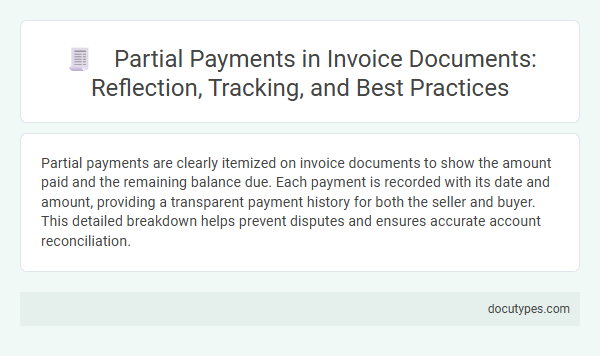Partial payments are clearly itemized on invoice documents to show the amount paid and the remaining balance due. Each payment is recorded with its date and amount, providing a transparent payment history for both the seller and buyer. This detailed breakdown helps prevent disputes and ensures accurate account reconciliation.
Introduction to Partial Payments in Invoice Documents
Partial payments allow customers to pay invoices in increments rather than in full at once. These payments are systematically recorded within invoice documents to ensure accurate tracking of outstanding balances.
- Payment Allocation - Partial payments are attributed to specific invoice line items or total amounts to reflect the reduced balance.
- Balance Updates - The invoice dynamically updates the remaining amount due after each partial payment is recorded.
- Payment History - Detailed records of all partial payments are maintained on the invoice for transparency and accounting accuracy.
Importance of Allowing Partial Payments
| Aspect | Details |
|---|---|
| Partial Payments Definition | Partial payments represent a portion of the total invoice amount paid by a customer before settling the full balance. |
| Reflection in Invoice Documents | Invoices display partial payments by showing the original amount, the amount paid, and the outstanding balance, often with clear dates and payment references. |
| Importance of Allowing Partial Payments | Allowing partial payments increases flexibility, improves cash flow, enhances customer satisfaction, and reduces payment delays, making it easier for both businesses and clients to manage finances. |
| Benefits for Your Business | Offering partial payment options encourages timely payments, lowers the risk of bad debt, and supports long-term customer relationships by accommodating diverse financial situations. |
Reflecting Partial Payments in Invoices
Partial payments are typically shown on an invoice by listing the amount paid alongside the original total. This helps to clearly indicate the remaining balance due, providing transparency for both parties.
The invoice usually includes a specific section labeled "Payments Received" or "Partial Payments," detailing dates and amounts. Your records remain accurate and up-to-date by reflecting these payments promptly.
Tracking Partial Payment Transactions
Partial payments in invoice documents show the amount paid against the total due, allowing clear visibility of outstanding balances. Tracking these transactions ensures accurate financial records and helps manage cash flow effectively.
- Transaction Date - The invoice records the specific dates when partial payments were made to provide a payment timeline.
- Payment Amount - Details of each partial payment amount are itemized to reflect remaining invoice balances accurately.
- Payment Method - The mode of partial payment, such as credit card or bank transfer, is tracked for auditing and reconciliation purposes.
Your invoice document consolidates these partial payment details, enabling transparent tracking and simplified account management.
Accounting Implications of Partial Payments
Partial payments are recorded in invoice documents as reductions in the outstanding balance, reflecting the amount already paid by the customer. Accounting systems adjust accounts receivable accordingly, decreasing the total due while keeping track of remaining balances. This practice ensures accurate financial reporting and effective cash flow management by maintaining updated records of partial settlements.
Common Challenges in Managing Partial Payments
How are partial payments reflected in invoice documents and what challenges arise in managing them? Partial payments are typically recorded as credits against the total amount due, showing the remaining balance clearly on the invoice. Managing partial payments can be challenging due to tracking multiple transactions, reconciling balances accurately, and ensuring clear communication with clients about outstanding amounts.
Best Practices for Recording Partial Payments
Partial payments are recorded in invoice documents to indicate the amount paid and the outstanding balance. Clear documentation ensures transparency and effective tracking of payments.
Best practices include specifying the date and amount of each partial payment directly on the invoice. Maintaining detailed records helps avoid discrepancies and supports accurate financial reporting. Including payment methods and references enhances clarity for both parties involved.
Automation Tools for Partial Payment Tracking
Partial payments are accurately recorded in invoice documents using automation tools that track payment statuses in real-time. This ensures your financial records remain up-to-date and transparent.
- Automated Payment Matching - Systems link partial payments to specific invoices, reducing manual errors and enhancing reconciliation efficiency.
- Real-Time Balance Updates - Automation tools update outstanding balances immediately after each partial payment, providing clear visibility of due amounts.
- Notification and Reporting - Automated alerts and detailed reports notify you of partial payments received and pending, improving cash flow management.
Communicating Partial Payment Policies to Clients
Partial payments on invoices are clearly itemized to show the outstanding balance and amount paid. This transparency helps clients understand their payment status and remaining obligations.
Communicating partial payment policies upfront prevents confusion and promotes timely payments. Clearly stating these policies in invoice documents ensures clients are aware of acceptable payment methods and deadlines.
How Are Partial Payments Reflected in Invoice Documents? Infographic

